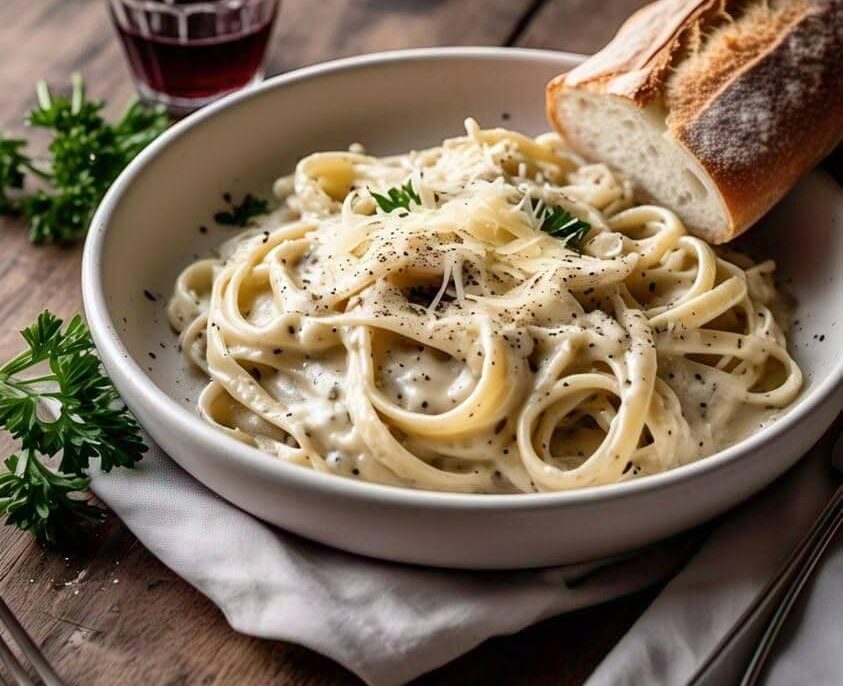Cacio e Pepe is the essence of Italian simplicity—a dish that requires just three key ingredients yet delivers a rich, creamy, and deeply satisfying flavor. Translating to “cheese and pepper” in Italian, this traditional Roman pasta is a staple in Italian cuisine, known for its velvety texture and bold taste. With just pasta, Pecorino Romano cheese, and black pepper, Cacio e Pepe proves that sometimes, the simplest ingredients create the most magical dishes.
The Origins of Cacio e Pepe
Cacio e Pepe has been a part of Roman culinary history for centuries. Originally a meal for shepherds, who carried dried pasta, aged cheese, and black pepper during long journeys, this dish evolved into one of Rome’s most famous pasta recipes. The magic of Cacio e Pepe lies in its creamy cheese sauce, created without butter or cream—just starchy pasta water and Pecorino Romano.
Ingredients You Will Need
For the Pasta:
- 12 oz (340g) spaghetti, tonnarelli, or bucatini
- 1 tablespoon salt (for boiling water)
For the Sauce:
- 1 cup (100g) grated Pecorino Romano cheese
- 1 teaspoon freshly ground black pepper (adjust to taste)
- 1/2 cup reserved pasta water (as needed)
Optional Additions:
- Extra Pecorino Romano for garnish
- A drizzle of extra virgin olive oil for richness
- A pinch of red pepper flakes for a slight kick
Step-by-Step Cooking Instructions
Step 1: Cook the Pasta
- Bring a large pot of water to a boil and add salt. Since Pecorino Romano is naturally salty, go easy on the salt in the water.
- Add the pasta and cook until al dente, following package instructions (about 8–10 minutes).
- Before draining, reserve at least 1/2 cup of pasta water—this will be key to creating a smooth sauce.
Step 2: Toast the Black Pepper
- While the pasta cooks, heat a large skillet over medium heat.
- Add the freshly ground black pepper and toast it for about 1 minute until fragrant. This step enhances its deep, warm flavors.
- Add a splash of reserved pasta water (about 1–2 tablespoons) to the skillet to infuse the water with the black pepper’s aroma.
Step 3: Create the Cheese Sauce
- In a separate bowl, mix the grated Pecorino Romano cheese with a few tablespoons of reserved pasta water to create a thick paste. This step helps prevent the cheese from clumping when added to the hot pasta.
- Stir vigorously until smooth. If needed, add a bit more pasta water until the cheese forms a creamy consistency.
Step 4: Combine Pasta and Sauce
- Add the drained al dente pasta to the skillet with the toasted black pepper.
- Remove the pan from heat and gradually add the Pecorino Romano paste, tossing constantly to coat the pasta evenly.
- If needed, add small amounts of reserved pasta water to help emulsify the sauce, creating a smooth and creamy texture.
Step 5: Serve and Enjoy
- Plate the Cacio e Pepe immediately while warm.
- Garnish with extra grated Pecorino Romano and freshly ground black pepper.
- Serve and enjoy the magic of Roman simplicity!
Tips for the Perfect Cacio e Pepe
- Use Freshly Grated Pecorino Romano: Pre-grated cheese may not melt properly, leading to clumps.
- Toast the Pepper First: This enhances its aromatic depth, creating a richer flavor profile.
- Don’t Drain All the Pasta Water: The starchy water is key to emulsifying the sauce, making it creamy without needing butter or cream.
- Stir Vigorously: To prevent clumping, mix the cheese paste with pasta off the heat, adding pasta water gradually as needed.
- Serve Immediately: Cacio e Pepe is best enjoyed fresh while the sauce is still creamy.
Cacio e Pepe is a timeless Roman dish that showcases the beauty of simple, high-quality ingredients. Whether you’re a pasta enthusiast or new to Italian cooking, this easy yet impressive dish is sure to become a favorite. Try this authentic Cacio e Pepe recipe and experience the bold, peppery, and cheesy flavors that make it a true Italian classic!





